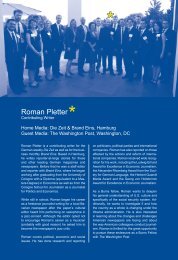Disaster and Crisis Coverage - International News Safety Institute
Disaster and Crisis Coverage - International News Safety Institute
Disaster and Crisis Coverage - International News Safety Institute
You also want an ePaper? Increase the reach of your titles
YUMPU automatically turns print PDFs into web optimized ePapers that Google loves.
✦ how a nuclear power plant works<br />
✦ why a particular area is subject to flooding<br />
✦ mining operations<br />
✦ manufacturing or chemical plant operations<br />
✦ prisons<br />
✦ municipal agencies responsible for infrastructure, etc.<br />
Consider providing safety training to the staff who might be sent to cover a<br />
disaster. The BBC, for example, has m<strong>and</strong>atory “hostile environment training” for<br />
journalists going into dangerous areas. The Committee to Protect Journalists has<br />
a free, useful guide to reporting on dangerous situations. (http://cpj.org/reports/<br />
2003/02/journalist-safety-guide.php)<br />
Train at least some staffers in first aid, CPR <strong>and</strong> AED (use of a portable<br />
defibrillator). The Reuters Foundation has a First Aid H<strong>and</strong>book online (http://<br />
www.newssafety.org/images/stories/pdf/safetyresource/guides/<br />
firstaidh<strong>and</strong>book.pdf).<br />
Review routines<br />
How much cash is kept on h<strong>and</strong>? If power fails, bank cash machines will not<br />
work <strong>and</strong> credit cards will not be accepted. When <strong>and</strong> where are news vehicles<br />
refueled? If the newsroom depends on just one gas station, what happens if it's<br />
closed down? When are batteries put on charge? When are computer files<br />
backed up –not just the main server but reporters’ laptops? Instill the habit of<br />
refueling, charging, <strong>and</strong> backing up at the end of every shift. Develop alternatives<br />
to allow publishing or broadcasting to continue in case a disaster affects the<br />
newsroom directly.<br />
Pre-produce<br />
Save time by pre-producing graphic or design elements for coverage of the most<br />
likely local disasters like weather emergencies or plane crashes. Create cameraready<br />
maps for locations like airport runways, train <strong>and</strong> bus stations, <strong>and</strong> major<br />
office buildings. For television, build a graphic for each reporter, including name<br />
<strong>and</strong> photo, to use during phoned-in live reports. Anticipate the kind of information<br />
that people will need after a disaster <strong>and</strong> create mock-up Web pages in advance.<br />
Consider producing a survival guide in advance for predictable, seasonal<br />
disasters like hurricanes or flooding.<br />
<strong>International</strong> Center for Journalists<br />
14
















